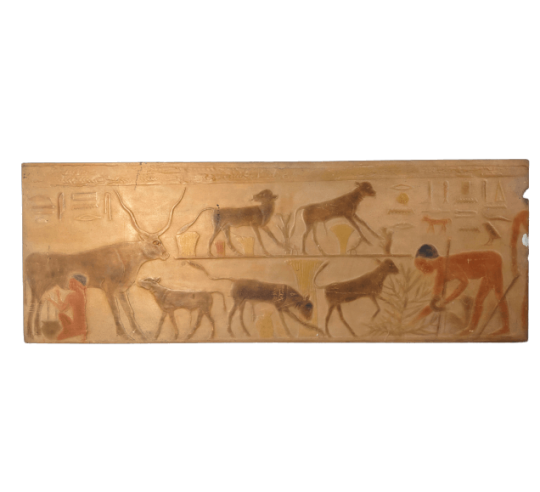- New
Egyptian low relief necropolis of Saqqara Mastaba de Ti, scene of cow breeding and milking.
Egyptian low relief necropolis of Saqqara Mastaba de Ti, scene of cow breeding and milking.
The role of cattle in the daily life of Egyptian peasants.
Cattle played an essential role in the economy of ancient Egypt by participating in agricultural work, serving as food for humans or providing raw materials for handicrafts. But they were also of great importance in religious belief and symbolism.
Role of cattle in the rural economy
The ploughing was most often done by two oxen, which pulled side by side a piece of wood whose ploughshare would be covered with metal in the New Empire. It was also at this time that the collar yoke was introduced by the Hyksos, together with horses.
Symbolism of the bull and the cow:
The cow is a symbol of maternity and we speak of "heavenly cows" which symbolize the heavenly vault. As for the bull, it refers to fertility, sexual power and physical strength. Kings were closely associated with this procreative animal par excellence. This theme of fertility would persist throughout the Pharaonic period and even beyond. Thus Diodorus of Sicily relates that women used to raise their skirts in front of Apis.
Dimensions
Height: 35 cm.
Length: 95 cm.
Reproduction entirely handmade.
Material : this reproduction is available in resin and plaster.
Available patina : bronze, terracotta, marble, wood, polychrome, gilding, stone or diorite.
Do not hesitate to consult us for the different prices (according to patina and materials).
In stock
Delivery time: Delivery within 15 days to 25 days.
Shipping: Shipping costs are automatically calculated when you finalize your purchase at checkout.
Egyptian low relief necropolis of Saqqara Mastaba de Ti, scene of cow breeding and milking.
Handmade reproduction entirely made and patinated by hand.
In stock
Height: 35 cm.
Length: 95 cm.
Other materials available: resin, reconstituted stone.
Patinas available: bronze, terracotta, marble, wood, polychrome, gilding, stone or diorite. Contact us to know the price of our patinas (variable according to the desired colour).
Delivery time: Delivery within 15 to 25 days.
Delivery times vary according to the state of our available stocks and the demand.
If the reproduction you want is not immediately available, we will contact you immediately by email to inform you of the average additional manufacturing time planned by our workshop.
The average times for each stage of production of our reproductions are as follows
Time required to make a mould in full time: 1 month.
Time to print a piece: 1 day.
Finishing time: Varies from one piece to another, on average one week.
International shipments guaranteed at the most economical rates.
Shipping costs: Shipping costs for available carriers are calculated automatically at checkout.
Scene of cow breeding and milking in ancient Egypt :
The domestication of animals in Egypt probably began as early as the Neolithic period. Under the Old Empire (from -2278 to -2260).
Four breeds of cattle are mainly known in ancient Egypt: the 'Negou' cattle, the 'Oundou' cattle, the hornless cattle and the humpbacked cattle.
The Negou cattle were the most common in ancient Egypt. They had long lyre or crescent-shaped horns, were tall on legs, thin and dry, with a short neck and a broad muzzle.
Well acclimatized to the climate of the Nile valley, these oxen grazed in large herds in the meadows of the delta.
During the hot summer months, the shepherds who herded these herds would take them to bathe in the deep waters of the Nile while keeping the crocodiles at bay with the help of magic spells.
Some subjects were fattened, and were then called "ioua" cattle. Beef ioua (or Bos Africanus of its scientific name) was not a working animal. It was intended exclusively for slaughter.









